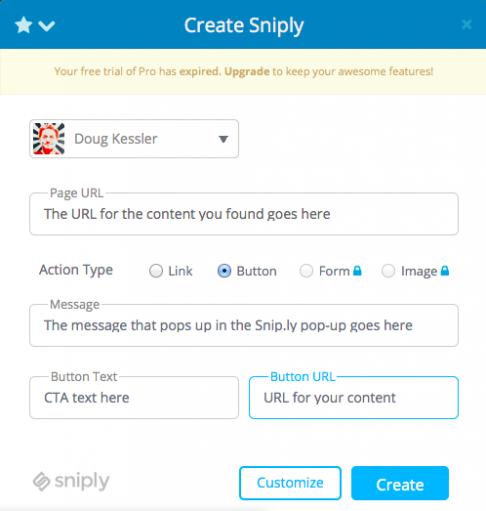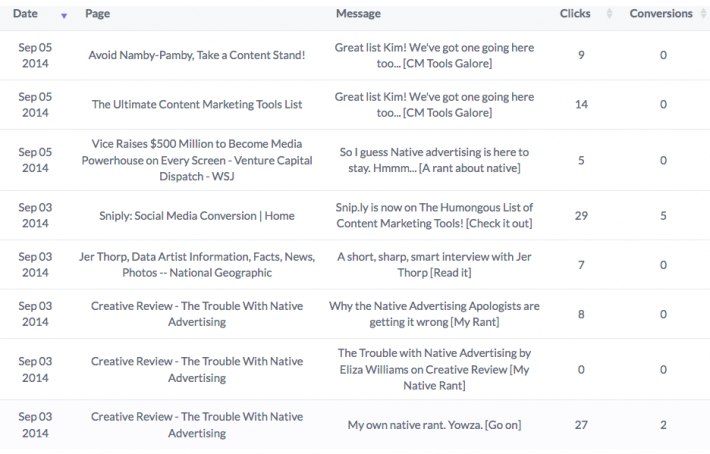Here’s a cool way to piggyback on popular content that you didn’t produce and use it to drive traffic to your own, related content.
It’s called Snip.ly and their strapline pretty much sums it up: “Attach a call-to-action to every link you share”.
How it works:
1) Find a piece of content that’s relevant and popular – something that you like; that’s getting a lot of traction (shares, likes, views); and that has a direct connection to a piece of content that you produced.
2) Snip it – create a Sniply by using the Snip.ly browser widget or the web app. Just put in the URL of the content you’re about to piggyback. Add a message and a button. Then add the URL of the content you want to promote. The interface is super-simple:
3) Generated a snip.ly URL – when you click ‘Create’ you get a shortened URL.
4) Share it – on social media (tweet it, post it on LinkedIn or Facebook, whatever).
That’s it.
When people click on your new link, they go to the popular content and the see a pop-up in the bottom left corner of the page that promotes YOUR content. It looks like this:
You’ve just used someone else’s great content to promote your own (presumably relevant and worthy) content. They get new traffic and clear attribution (it’s good to give credit when you tweet using the Snip.ly URL). And you get a shot at new traffic for your related content — which they call a conversion.
Analytics
The reporting is clear and simple, too. For each Sniply you create, it shows the number of clicks (when people click the post that uses the URL) and the conversions (the number of times someone clicked your CTA button to see your related content. The dashboard looks like this:
Results
Those really are the stats for our first few experimental snips. Yours will vary by how many followers you have, how often you share the sniply, how popular the ‘mother’ content is and how compelling your secondary content offer is.
As you can see, our early tries did get clicked (we were sharing popular content after all). But we didn’t get very many conversions. I think we’d get more if we got better at this.
We only got one negative tweet — someone objecting to our having a pop-up on one of their favorite sites. I understand this and can see how some might find this a bit crass. But I think if you really do like the content you’re riding and have really relevant content as a follow-up, it should be seen as adding value.
Some might feel that you only shared the mother content so that you could squeeze out some clicks to your own – and I guess they’d be right. But if you’re sensitive about the content you share and the content you use as the follow-up, you ought to be okay. If you disagree, please comment below.
Pricing
Basic is free, for one user profile, unlimited links and up to 100 conversions a month.
Premium is $16 a month (billed annually) and you get up to 500 conversions a month and some more customisation options.
Business is $85 a month for up to 5,000 conversions a month and the ability to connect to your analytics.
The bottom line
Snip.ly is like other URL shorteners that let you put a social bar at the top of shared pages (like Hootsuite’s Ow.ly shortener). But those just let you put a standard bar on top for all posts. Snip.ly is better because it lets you customise the pop-up for the specific content you’re sharing and promoting.
It does take effort to find related content, generate a snip (less than two minutes) and share it. If you use the browser widget, you’ll probably get in the habit of snipping great content as you come across it on the web.
Our conversions were low (the best being my ‘meta’ snip — an attempt to ride the Snip.ly site itself to pimp our Humongous List of Content Marketing Tools (which I’d just added Sniply to.) (I know: whoah — it’s like Inception). I suspect we’d get better at snipping and might earn some decent conversions.
Snip.ly is a simple idea, well executed. It’s clean, intuitive and super-easy to use.
There may be something a little… tricksy about using someone else’s content to drive people to your own. But like so many content promotion tactics, it depends on how you use it. Use it intelligently and there’s a good argument for including it in your content pimping arsenal.
Give it a go and let us know what you think.

Enjoyed this article?
Take part in the discussion











Comments